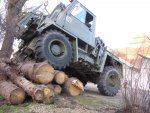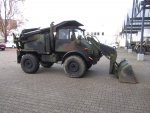My insurance agent informs me that I'll need on-site visits (at my expense, of course) from underwriters' adjusters -- one from the insurance provider for the FLUs, and another for the GMCMH. Nutshell on the FLUs, is if you intend to register them and get license plates, in CO that requires at least liability coverage, from an underwriter who may only have a handful of policies covering others' FLUs... what they want to see is a stock FLU, not one that's been modified into a snowblower, if you catch my drift.
Coverage for a heavily-modified GMCMH as my primary residence has led to some interesting exchanges via my local insurance agent. Adjusters routinely inspect boats, underwriters are aware that RVs aren't subject to those requirements, just those of manufactured housing and vehicles, but there's overlap in regs (boats need D.O.T. highway-approved propane tanks). The upshot of which, is by adhering to boat regs and *not* having a propane fridge, I'll save enough on the policy to more than pay for the site visit.
I could go with propane hoses, but 1/4" ID is 1/2" OD with nowhere near the radius of comparable copper tubing, so I'm going with copper tubing in my tiny li'l space. Unlike the original GMC design, I can't just have one propane line leading from the tank and branching off to various appliances. I *must* have an individual line and shutoff for each appliance, leading from a manifold in my propane compartment.
Also, I must install a shutoff solenoid between the tank & regulator, connected to propane sniffers in the "house" and the propane compartment. While my heaters will have isolated combustion circuits with external intake/exhaust, that is a gas range I'm installing, so I'm required to have a CO detector -- also for running the 6KW Onan. Smoke detectors required. Also, and I don't know how I'll ever get a blower-door leak test as my door is curved (maybe build a plywood "jig" for the back cap before it's put back on, to account for the leakage of my one door and be as useful a data point for me as it is for the insurace co), but below a certain volume and above a certain leak value, there's a requirement for an oxygen-concentration alarm.
Yeah, I've been at the GMCMH project for a while, but it's good to finally have my insurance ducks in a row. Refurbishing means you have to jump through all the same hoops the insurance industry requires of anyone manufacturing new motorhomes. I even got my NOS 3-point seatbelts in the other day, to replace the stock lap belts. The 3-point belts were an option when new, so there's a mounting point already there on my frame. In a rollover, the actuarial tables show that the lap belt was more survivable than the 3-point, but that choice is up to them not me! I've never rear-ended anyone in my life, but I guess you get elderly folks driving RVs around and it's so common to rear-end someone that the risk managers insist on the 3-point belts. My Mom had her first car accident ever last year -- rear-ended someone. I told her to buy a new car, they have computers for that now!
Whereas I'm not wearing my seatbelt out of concern of running into anything. It's the insane logging truck coming at me that'll put me over the edge one of these days, and I'd hate my epitaph to read, "Killed by shoulder-harness in rollover" when a lap belt woulda been adequate. I had to find NOS 3-point belts, because while newer alternatives will fit, those belts are designed to give in conjunction with the airbag system my '77 GMC just doesn't have. They're out there to find, and not all that costly.
Oh! You can't put integrated-belt seats on the existing mounts in the GMC without reinforcement, and you'll still have the "give" problem. What this means, is I can now also shop for "helm chairs"...
https://www.llebroc.com/product-p/4brbanl01.htm
...instead of "captain's chairs," because the 3-point harness and the chair are independent from one another. If the chair breaks loose, I'm not going anywhere if I'm buckled in... unless rollover... if I'd put the GMC off the road where I did the SEE a while back, the sideways deflection of the upper frame would've caused the driver's-side shoulder harness to tear me in half diagonally, if it'd gone over. A survivable scenario with just a lap belt.




